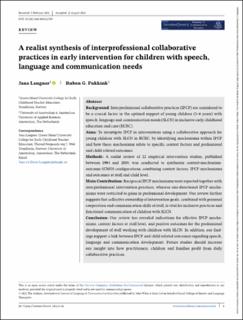| dc.contributor.author | Zwart-Langner, Jana van der | |
| dc.contributor.author | Fukkink, Ruben G. | |
| dc.coverage.spatial | Norway, Trondheim. | en_US |
| dc.date.accessioned | 2022-10-20T12:03:29Z | |
| dc.date.available | 2022-10-20T12:03:29Z | |
| dc.date.created | 2022-10-18T13:03:51Z | |
| dc.date.issued | 2022-08-21 | |
| dc.identifier.citation | International journal of language and communication disorders. 2022, 1-26. | en_US |
| dc.identifier.issn | 1368-2822 | |
| dc.identifier.uri | https://hdl.handle.net/11250/3027317 | |
| dc.description.abstract | Background: Interprofessional collaborative practices (IPCP) are considered to be a crucial factor in the optimal support of young children (3–6 years) with speech, language and communication needs (SLCN) in inclusive early childhood education and care (ECEC). Aims: To investigate IPCP in interventions using a collaborative approach for young children with SLCN in ECEC, by identifying mechanisms within IPCP and how these mechanisms relate to specific context factors and professional and child-related outcomes. Methods: A realist review of 22 empirical intervention studies, published between 1994 and 2019, was conducted to synthesise context-mechanismoutcome (CMO) configurations, combining context factors, IPCP mechanisms and outcomes at staff and child level. Main Contribution: Reciprocal IPCP mechanisms were reported together with interprofessional intervention practices, whereas one-directional IPCP mechanisms were restricted to gains in professional development. Our review further suggests that collective ownership of intervention goals, combined with personal cooperation and communication skills of staff, is vital for inclusive practices and functional communication of children with SLCN. Conclusion: Our review has revealed indications for effective IPCP mechanisms, context factors at staff level, and positive outcomes for the professional development of staff working with children with SLCN. In addition, our findings support a link between IPCP and child-related outcomes regarding speech, language and communication development. Future studies should increase our insight into how practitioners, children and families profit from daily collaborative practices. | en_US |
| dc.description.abstract | A realist synthesis of interprofessional collaborative practices in early intervention for children with speech, language and communication needs | en_US |
| dc.language.iso | eng | en_US |
| dc.publisher | Wiley | en_US |
| dc.rights | Attribution-NonCommercial-NoDerivatives 4.0 Internasjonal | * |
| dc.rights.uri | http://creativecommons.org/licenses/by-nc-nd/4.0/deed.no | * |
| dc.subject | interprofessional collaborative practices, | en_US |
| dc.subject | speech language and communication needs, | en_US |
| dc.subject | early childhood education and care, | en_US |
| dc.subject | IPCP mechanisms | en_US |
| dc.title | A realist synthesis of interprofessional collaborative practices in early intervention for children with speech, language and communication needs | en_US |
| dc.title.alternative | A realist synthesis of interprofessional collaborative practices in early intervention for children with speech, language and communication needs | en_US |
| dc.type | Peer reviewed | en_US |
| dc.type | Journal article | en_US |
| dc.description.version | publishedVersion | en_US |
| dc.rights.holder | ©2022 Authors | en_US |
| dc.subject.nsi | VDP::Spesialpedagogikk: 282 | en_US |
| dc.subject.nsi | VDP::Special needs education: 282 | en_US |
| dc.source.pagenumber | 26. | en_US |
| dc.source.journal | International journal of language and communication disorders | en_US |
| dc.identifier.doi | 10.1111/1460-6984.12789 | |
| dc.identifier.cristin | 2062390 | |
| dc.source.articlenumber | 12789 | en_US |
| cristin.ispublished | true | |
| cristin.fulltext | original | |
| cristin.qualitycode | 1 | |

